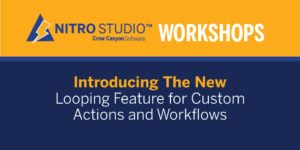We have an exciting new feature to share with you! We have added a Loop Control feature to our NITRO Workflows and Custom Actions!
What it is
What this means is that you can now re-run multiple actions multiple times within one workflow execution. This opens the possibility for several different actions that were previously difficult or impossible to configure in NITRO. For example, you can now:
- Update items in a list based on a response from a web service
- Create a set number of Assets automatically based on user input
- Send emails to different people based on items found in a query
- Close out a Problem Ticket, related Tickets, and those Tickets’ Tasks, with one click of a button
Here is a link to our article on how to configure the loop action: Configuration of Loop feature in Custom Actions and NITRO Workflows – Crow Canyon Software Support
For a detailed description of the above use cases, you can read this article: Sample Use Cases for Loop Feature in Custom Actions and NITRO Workflows – Crow Canyon Software Support
Of course, with a Loop, you’ll need to tell the program how many loops to perform before exiting the loop. With our Loop control, you can do this in several ways. You can simply specify the number of times to loop through the loop. You can also use a placeholder to determine how many times to iterate through the loop. For example, if you want to create multiple Assets of a particular Asset Type, you can have a number field on the Asset Type form where you specify how many Assets of that Asset Type to create.
You can also specify a date range and iterate through the loop between two dates. An example of this is where you want to create multiple Preventative Maintenance tasks between two dates, like the first day in the quarter and the last day in the quarter.
You can query a list in SharePoint to get the number of items that meet certain conditions. The Loop Control can then be configured to iterate through the loop on each one of those items. This example is described below.
Finally, you can use a Variable Collection to iterate through the loop. For example, you can scan one or more barcodes into a field, and then take an action on each Asset or SharePoint item that matches each barcode you scanned.
To help explain how the Loop control works I’ll walk through the example where you can close multiple Tickets and multiple Tasks with one click of a button.
The problem
In our IT Help Desk, you have a Problems list. This Problems list can in turn have multiple IT Tickets associated with it. Those IT Tickets can have multiple tasks associated with each one of them. In this scenario, what you want to do is close out all the Tickets and Tasks, and then close the Problem with one click of a button.
The solution
Here’s how to set that up.
In your Custom Action designer interface, first get the collection of Tickets related to the Problem using a Query List Action.
Next, use the Loop Control. Because you can refer to the Query List action from the Loop Control, the Loop Control feature will know how many Tickets it found related to the Problem. Every time you run back through the loop, it will pick up the next Ticket found in the Query List action, and run through the set of actions on the new Ticket. It will keep doing this until all the Tickets found in the query have been addressed.
Because the workflow knows which Ticket is being addressed in the current loop, you can use the ID of that Ticket to pick up all the related Tasks through another Query List action. Since you don’t need to loop through each Task, you can use the Update Item action, refer to the Query List action, and close all of the Tasks found in the query.
Then close the current Ticket and loop back to get the next ticket to run through the process again!
Here is what the above looks like in our Custom Action designer:

#LoopControlFeature
What’s next
With this new feature you can set up loops within loops, create multiple items at one time, send multiple emails to multiple people, and much more! Contact sales@crowcanyon.com to learn more.


